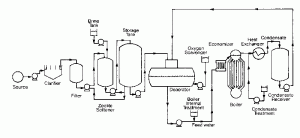The decision to invest in products with the aim of increasing efficiency is not necessarily an easy one. On one side of the scale, there is pressure to complete a job with a budget that remains inside the initial parameters. On the opposing side is the notion that, although equipment comes with cost, the right efficiency-boosting hardware can be the ultimate cost-saver in its linear relationship with time. It follows, naturally, that being able to properly quantify the costs one will incur and savings one will enjoy is a crucial factor to consider when it comes to such products.
This installment of Product of the Month addresses this question as it relates to economizers. This post will be dedicated to a background and overview of economizers, and we will later turn our focus to types of economizers, as well as a profile on some of the products we carry and partners that CANNEPP represents.
Taking back what’s yours
Flue gasses leaving larger steam boilers can range from 450-650 degrees Fahrenheit. If heat from combustion can be reclaimed, pre-heating make-up water going into a boiler is not only economically prudent, but can help to reduce risk of thermal shock. Economizers are part of the answer to these considerations. Depending on the location, size, type of boiler used and its applications, stack or condensing economizers can make a critical impact.
The Boiler Consortium of the Energy Solutions Center in Washington, DC notes that stack economizers are an ideal option when large amounts of makeup water are being used or there is a high demand for hot water for alternative functions. The ESC attributes a high demand for make-up water to two scenarios: either not all condensate is returning to the boiler, or there is a need for large volumes of hot water for other processes. Because stack economizers vary greatly in size, the boiler and its applications are assessed, along with the volume of water it uses, to properly estimate cost-savings.
Condensing economizers can dramatically boost thermal efficiency, making available the energy recovered from the latent heat of condensation during the state change of flue gasses at the dew point. Condensers are a more feasible option when higher volumes of water need to be heated to a temperature lower than what is achieved with stack economizers (See: CBW, Gas condensing water heaters). Condensers can also be employed in both small and large boiler scenarios.
In the next weeks’ posts, we will delve further into the heat transfer surfaces and processes by which different types of economizers achieve these purposes.
In the line of fire
There are a number of ways that economizers can be utilized to increase boiler plant efficiency. The first distinction to draw is the difference between methods of capturing heat to direct to feedwater. Economizers function primarily by running feedwater through the inlet of a finned-tube heat exchanger that is in the path of the flow of combustion gases leaving the boiler. This is referred to as indirect contact. Some condensing economizers are direct contact units, which spray water onto the flue gasses in order to extract heat. A packed-mass heat transfer zone, likely made of stainless steel, ensures that the cold-water supply being sprayed absorbs as much heat as possible (See: ESC, Flue gas condensers).

Harnessing extra energy from combustion heat to increase the temperature of feedwater to the boiler results in significant long-term cost savings and increased boiler longevity.
In a condensing economizer, the low temperature of stack gas will cause condensate to develop. Because this condensate contains dissolved acidic components, using baffles to drain such material can be necessary. Many economizers today, however, have a makeup of materials that do not corrode under the same conditions.Using an economizer to preheat feedwater to the boiler can result in significant savings and increased longevity.
More money, less problems
Economizers equip you with a multitude of possible solutions for increasing the efficiency of your operations. A commercial laundry company could, hypothetically, find that sending the additional heat recovered to mix with the city water used for the wash process, rather than preheat the incoming feedwater, takes overall efficiency increases from 2.5% to 4%. Regardless of what solutions are reached, Economizers used alongside the appropriate equipment and controls can make a boiler system 90% efficient and help cut greenhouse gas emissions by a tenth.
According to Cannon Boiler Works, 96% of the costs associated with a boiler over a twenty-year period comes from the fuel, with 10-20% of lost energy resulting from heat escaping into the atmosphere. They go on add that if you subtract 5-10% from your total annual boiler fuel bill, and find that to be a significant number, then an economizer already makes sense. Also considering fuel type, exhaust back-pressure, and inlet water temperature can help you narrow the field and effectively choose the right product for your heating solution.
On deck
Visit us again next week for the second installment of this month long, in-depth look at economizers in the boiler room. Next up – a closer look at stack economizers and condensing economizers, as well as info on the economizers that CANNEPP is proud to represent.
Reference List
The Boiler Consortium of the Energy Solutions Center, Washington, DC
https://www.energysolutionscenter.org/
http://cleanboiler.org/learn-about/boiler-efficiency-improvement/boiler-efficiency/
Cannon Boiler Works – Boiler Economizers
http://cannonboilerworks.com/boiler-economizers/
The Basics of a Boiler Stack Economizer – Cleaver-Brooks tip sheet
http://www.cleaverbrooks.com/reference-center/resource-library/tip-sheets/2010-tip-sheets/the-basics-of-a-boiler-stack-economizer.aspx

